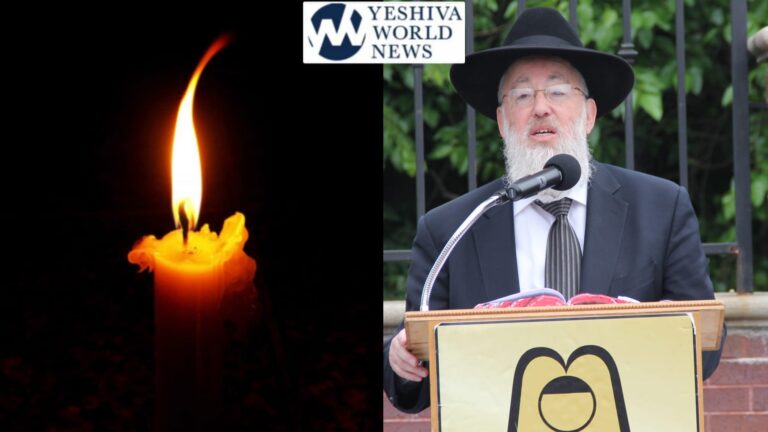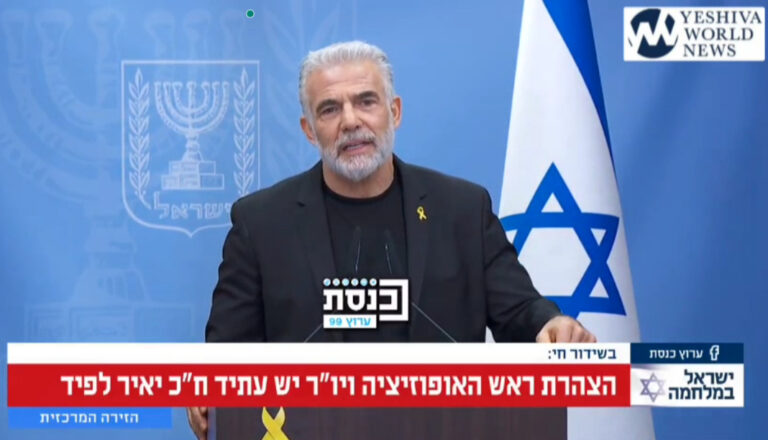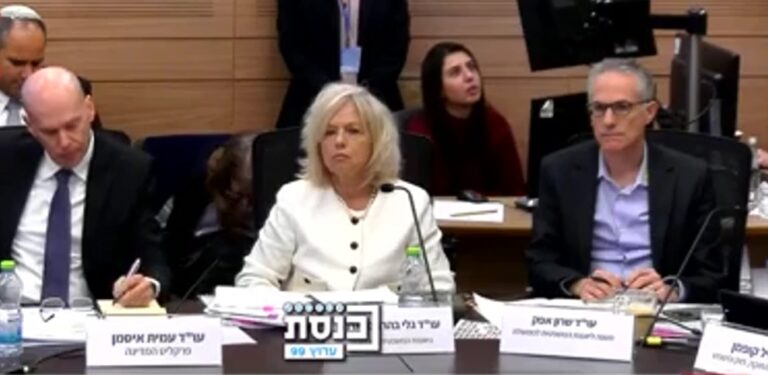 In anticipation of an impending Erev Shabbos snowstorm (a 2-foot, 55 mph wind blizzard, in our case, this Shabbos, in Baltimore), the Star-K has provided the following two items for the YWN readership.
In anticipation of an impending Erev Shabbos snowstorm (a 2-foot, 55 mph wind blizzard, in our case, this Shabbos, in Baltimore), the Star-K has provided the following two items for the YWN readership.
First is a “Halachic Guide for the Delayed Friday Afternoon Traveler”, a Kashrus Kurrents article by STAR-K Kashrus Administrator Rabbi Dovid Heber.
At the end of the article is “Storm Weather and Halacha”, a video presentation featuring STAR-K Kashrus Administrator Rabbi Zvi Goldberg, who discusses the halachic implications involved in storm weather (snow on Shabbos, etc.). Guest speaker is Rabbi Mordechai Frankel, Director of STAR-K’s Institute of Halacha.
Every few months, the phone rings on Erev Shabbos with a similar shayla: “We are not sure if we will reach our destination in time for Shabbos. What should we do?” If the call comes from people who are stuck in traffic, my response has been, “Are you calling to find out thehalachos, or to hear the best alternate routes to reach your destination?”
After determining where they are, how much time they have until Shabbos begins, and their different options, I then advise them on what the halachos are. Last spring, there was a major storm on erev Shabbos and commuters from Baltimore who worked in Washington, DC were in a bind, as no late afternoon trains were running from Washington to Baltimore. At my Shabbos table that night, I related an earlier conversation and halachic discussion that I had with a baal habayis stuck with other Shomer Shabbos passengers on a train. After hearing the details, my wife suggested that I write an article about this important and very relevant issue.
The following is based on the psak of Rabbi Moshe Heinemann, shlita, Rabbinic Administrator of the STAR-K.1
I. Preparing Before Shabbos
It is important to leave enough time before Shabbos to reach one’s destination.2 When traveling long distances, one should ideally travel early in the week or no later than Thursday. If this is not possible, then one should not schedule a trip (whether by car, bus or train) if one would arrive at the destination too close to Shabbos. Ideally, set aside double the amount of time it normally takes for Friday travel and take into account a possible bus or rail mechanical delay or highway traffic jam with traffic at a standstill, and no good alternate route. These occurrences are, unfortunately, quite common and will lead to possible chilul Shabbos and cause unnecessary stress. Leave enough time, especially before holiday weekends, if inclement weather is forecasted or if there is major construction en route. Similarly, one should not take the last pre-Shabbos flight3 (i.e., the last Friday afternoon flight that reaches one’s destination before Shabbos) or flights that arrive too close to Shabbos. Traveling too close to Shabbos to work a few more hours or save some money with a more economical flight is generally not the correct thing to do.
II. Friday Afternoon Troubleshooting
When one knows that he will not reach his destination, it is advisable to find a hotel room well before Shabbos. For example, the drive from the Delaware Memorial Bridge to Baltimore typically takes an hour and a quarter. If it is one hour before sunset on a Friday afternoon, one may not continue to travel at 85 mph to reach Baltimore. Besides putting oneself into a situation that may lead to chilul Shabbos, such “heroic acts” are illegal, foolish and dangerous. In such a situation, one should exit and, if possible, go to the closest Orthodox community or neighborhood that one can reach before Shabbos.4 In this case, one might arrange to spend Shabbos in Philadelphia, PA or Wilmington, DE. If this is not possible, one should check into a hotel before Shabbos and purchase at least “basic necessities” for Shabbos, ensuring that all food products that require kosher certification have a reliablehechsher.
When traveling on Friday, it is advisable to take along a box of matzos or rolls, in case one gets stuck. If kosher wine or grape juice is not available, Friday night Kiddush5 may be recited on challos, or any other Hamotzi item. In such a case, one should substitute the brocha ofHamotzi in place of Borei Pri Hagafen and ideally recite Kiddush on “shalem” (complete)challos, rolls, bagels, buns,6 or matzos for lechem mishneh. If this is not possible, one may recite Kiddush on a slice of bread (i.e., even if one does not fulfill lechem mishneh). If none of the above are available, one may eat without Kiddush.7 For Shabbos lunch and Havdalah, if kosher wine or grape juice is not available, one may use chamar medina (e.g., ideally beer but, if not possible, iced tea).8 Candles should be lit before Shabbos. If candles are not available or permitted, one should use flashlights or b’shaas hadechak (if there is no other option), turn the hotel room incandescent lights9 off and then on and recite a brocha.10
III. Stuck on the Road When Shabbos Is About to Begin – General Guidelines
In order to understand these halachos, it is important to review some generally relatedhalachos.
- Danger – If necessary, one must be mechalel Shabbos if one is in danger (or there is a possible danger). For example, if on a Friday afternoon, a person is driving on an expressway with no viable exit in sight and the sun is setting, one may continue driving until11 reaching a safe location. This is because getting out of one’s car and walking on the shoulder of an expressway is sakanas nefashos (dangerous) – especially at night or in bad weather. The same is true if one is in a dangerous neighborhood. However, one may not be mechalel Shabbos to reach an “ideal” destination. For example, if one reaches a rest stop that is populated, serviced and open 24 hours a day (e.g., on the New Jersey Turnpike), or a hospital (if one can stay in the waiting room) before Shabbos,12 one must spend Shabbos in such a location and may not drive to reach a more preferred location.
- Amira L’Akum – In general, one may not ask a non-Jew to perform work for him on Shabbos. Therefore, unless one is ill or in danger, on Shabbos one may not ask a taxi driver to drive him to his destination. During bein hashemashos (twilight), one may ask a gentile to perform melacha if it is l’tzorech mitzvah (to perform a mitzvah).13 Getting home is certainly a necessity to experience oneg Shabbos. So, if one is on a plane that landed just before Shabbos, one may enter a taxi that will travel even after Shabbos begins, provided that he will reach his destination within 30 minutes14 after sunset.15
- Tchum Shabbos – One may not go more than 2,000 amos (about two-thirds of a mile) past the end of the town in which he is located when Shabbos begins.16 Therefore, one may not travel from one city to the next once Shabbos has begun – even if a gentile is driving.17 Furthermore, one may not be in a taxi or on a train when Shabbos begins (at sunset) if he will leave the tchum on Shabbos. One should not fly on a plane that will take off or land on Shabbos.18 Similarly, one should not board a train or plane – even before Shabbos – which will depart on Shabbos.19
Generally, if one reaches his destination from outside the tchum on Shabbos, one may only walk four amos (about 7 feet) in each direction.20 In this case, we do not consider the entire city as inside his tchum. However, the following are considered “inside four amos”:
a) Inside one building21 (e.g. airport or home)
b) A fenced-in area that includes a place where people generally eat and sleep (mukefes chomah l’dirah).
c) Inside an eruv. For example, if someone from outside the tchum came b’issur(in a way that was halachically prohibited) on Shabbos to Northwest Baltimore, where there is an eruv, he would be allowed to walk anywhere inside the eruv.22
Furthermore, if one cannot stay in this location for the following reasons, one may go to the closest safe location:
a) If one is being forced to leave his current location. For example, if one arrives at a train station which is not open 24 hours.
b) If one needs to go to the bathroom, and none are available at his current location.23
c) If his current location is a dangerous place.
If one boarded a plane thinking he would land before Shabbos, but then the plane ran late and landed on Shabbos, one must remain in the airport building for the entire Shabbos. One must de-plane before takeoff if he realizes he will land after Shabbos starts. If the airport will close (e.g., a small town airport), one may take a taxi to the closest safe location.
IV. What to Do In Specific Situations
A. Driving – Ideally, when one realizes that he will not reach his destination before Shabbos, he should find a hotel or safe rest stop before Shabbos begins. It is advisable to do this as early as possible before Shabbos. If it is close to sunset, one must exit, park his car and lock his possessions in the car (or find a gentile who will watch them on Shabbos) before sunset. He should then walk to his destination (if it is within the tchum). One may continue to drive if it is dangerous to stay where he is. He must stop driving when it is safe enough to walk.24 For example, if one exited the expressway near his house and it is after sunset, he must get out of the car and walk the rest of the way.
B. Train or Bus (driven by a gentile) – One must get off before sunset. If one is in the tchum when Shabbos begins, b’shaas hadechak one may stay on the bus or train until one reaches his destination. If one will leave the tchum (e.g., one is in Edison, NJ at sunset and the train is going to New York), one must get off before sunset. If this is not possible (e.g., the train or bus driver will not let him off, or if it is a dangerous location), upon arriving at his destination, he may only walk four amos.
C. Plane – As indicated above, one should not be on a plane that will take off or land on Shabbos. If one was on a plane in the air when Shabbos began, the following applies when landing: If the airport one lands in is inside the tchum of the city and one was over the city at sunset (e.g., a flight into Midway Airport and at sunset the plane was over Metropolitan Chicago), upon landing, one may walk anywhere in the city (e.g., all of Chicago). However, if the plane was outside the tchum25 of the destination at sunset, or the airport is outside the tchum, one must stay in the airport building for the entire Shabbos.
D. Taxi – As discussed earlier, if necessary, one may travel by taxi during twilight. This is true, whether he enters the cab before or after sunset. If he enters the cab after sunset, the driver should open the door for him. The driver should also open the door when he reaches his destination. After Tzais Hakochavim, one may stay in the taxi driven by a gentile driver if one is ill or in a dangerous location. Some poskim allow one to stay in the taxi (or have a gentile drive his car) after nightfall in cases where there will be a significant monetary loss, or if one lacks basic necessities (e.g., he will have to spend Shabbos in his car). Upon reaching ones destination, to avoid handling muktza, the taxi driver should be shown where the money for payment is.26
It is important to remember that when one needs to travel on erev Shabbos, it should be done in a way that does not risk sacrificing “kavod and oneg Shabbos”, and which does not lead,chas v’shalom, to chillul Shabbos. Although it is impossible to anticipate every possible scenario when traveling on erev Shabbos, it is important that our plans not compromise or jeopardize our observance of Shabbos and kavod v’oneg Shabbos. This will allow our families to serve the Ribbono Shel Olam through the “Hailige Shabbos” – l’shaim ul’tiferes.
1. Ideally, if time permits, one should consult with his/her Rav to determine the ideal course of action, as each case is different. What follows are general guidelines that obviously cannot cover every possible scenario. For further detailed explanations of these halachos, see Sefer Yoshav Ohel by Rabbi Avrohom Ort and “Halachos for the Traveler” by Rabbi Doneel Epstein.
2. These halachos are discussed in Shulchan Aruch Orach Chaim (O.C.) Siman 248 and 266.
3. “Last flights” before Shabbos on some airlines may be a lot earlier than one realizes. For example, during much of the year, the last pre-Shabbos flights on Southwest Airlines from the West Coast to the East Coast leave early Thursday afternoon. If there is a mechanical or weather delay, there is no way to make it home before Shabbosunless one pays a huge sum of money to a different airline for a “walk-up fare” on a flight that leaves Thursday night. This is because Southwest has no “red eye flights” and will not transfer passengers to other airlines. When flying overseas (e.g., to Israel or Europe), it is advisable to leave by Wednesday night to arrive at one’s destination by Thursday. Exercise caution when booking reservations – especially when one has to change planes en route. A missed connection may mean spending Shabbos in a foreign city, causing much aggravation and expense. Furthermore, some Wednesday night flights to Israel stop in Europe for lengthy periods of time and one does not arrive in Israel until Friday. When traveling to the Far East or Australia, note that the Wednesday night flights arrive there on Friday. Tuesday night (or earlier) flights are advisable.
4. Contact Shabbat.com at 718-705-5000 for assistance in finding a home for Shabbos.
5. Rabbi Heinemann once asked Harav Moshe Feinstein zt”l, whether one sings Shalom Aleichem if he is ill at home (since malachim did not escort him to his home). Rav Moshe said ‘Yes’, since he is an oness (difficult circumstance with no other option). So, too, a person stuck in a hotel would also sing Shalom Aleichem.
6. If they are sliced, they are acceptable with the following conditions: a. The two halves are still attached;
b. When picking up the smaller piece, the larger piece remains attached and does not break off.
7. Mishna Brura 289:4. If one knows that Kiddush will be available within the next few hours, it is preferable to wait.
8. During the day, if one does not have any of the above beverages then recite Hamotzi on bread (if available) forKiddush before eating anything else (Mishna Brura 289:10).
9. The lights or flashlights may not be fluorescent or LED, as these may not be used for neiros Shabbos.
10. In general, if a woman was stuck on the road or in a place that is impossible for her to light candles, she would not have to light an extra candle for the rest of her life. This is because in such a situation, she is anoness (in an impossible situation). An extra light is added only if one was negligent or forgot to light (seeShemiras Shabbos K’Hilchoso 43:5). If one is in doubt regarding these matters, consult a Rav.
11. If possible, minimize the chilul Shabbos (e.g., use hand signals instead of electronic flashing signals, which involve performing a melacha), and upon reaching the destination hint to a gentile to turn off the engine.
12. The same would typically apply if one reached such a destination on Shabbos.
13. For a full discussion of amirah l’akum and other heterim during Bein HaShemashos, see Shulchan Aruch O.C. 342.
14. There are various opinions regarding the length of Bein Hashemashos. For this heter in the halachos ofamira l’akum, we recommend 30 minutes as the approximate time of Bein HaShemashos provided one has not been mekabel Shabbos (see Teshuva #44 of Harav Moshe Feinstein zt”l, in the back of Halachos of Shabbos by Rabbi Shimon Eider). Note: This time may be shorter in the southern United States.
15. Once nightfall has arrived, one may not ask a gentile to perform melachos d’Oraysa. Under certain circumstances (e.g., for a mitzvah or Oneg Shabbos), one may ask a gentile to perform a melacha d’rabananeven after nightfall and on Shabbos day. Therefore, he may be asked to carry one’s belongings necessary for Shabbos in an area that is not a reshus harabim d’Oraysa.
16. “Town” does not mean the city limits but, rather, the end of where people reside. So, typically a densely populated city is in one tchum. If at the end of the city (where neighborhoods are more spread out) there is a gap of 141.42 amos (about 250 ft) between neighborhoods, one may only walk 2,000 amos from where houses first end. In unpopulated areas, one’s tchum is 2000 amos in each direction from where he was when Shabbosbegan. Determining the tchum, especially in cities, is quite complex and difficult to ascertain without consulting a local rav.
17. Even according to the opinions which hold that one does not establish a tchum while in motion (see Emek Hateshuva by Rabbi Y. Roth, chalek 1 siman 20), the above case is assur since one can assume the car will have to stop at a light or in traffic.
18. Regarding flying in and out of Shabbos by crossing the International Dateline, see A Traveler’s Guide to the International Dateline on our site.
19. Regarding ships that travel or dock on Shabbos, see Don’t Miss the Boat: Halachic Guidelines of Kosher Cruises by Rabbi Zvi Goldberg, available on our site.
20. “Each direction” means to the north, east, south and west. Diagonally, the distance is 5.6 amos (about 10 feet – see Rama O.C. 396:1).
21. This is true if people eat and sleep at this location (i.e., it is mukefes chomah l’dirah – see Shulchan AruchO.C. 405:6).
22. See Mishna Brura 405:22 and Biur Halacha 405:6 “Aval†where he notes the opinion of the Rashba, Ritva, and Tosfos (Eiruvin 29a – V’hoshevo Reb Mayer) , and what is mashma from the Grâ€a.
23. Shulchan Aruch O.C. 406:1.
24. One should hint to a gentile to turn off his car.
25. The issue of tchum is quite complicated. In these cases, one can assume he has left the tchum when taxiing on the runway.
26. Halachos for the Traveler, page 65
01-28-2015 Storm Weather And Halacha from STAR-K KOSHER CERTIFICATION on Vimeo.
(YWN World Headquarters – NYC)











One Response
Thank you for this informative article. I was wondering if anyone can explain why the area between Edison and nyc is considered two tchumim if there are no breaks in the built up areas between the two. Am I factually wrong or halachclly wrong? If there is continuous housing between Edison and nyc isn’t it one tchum?